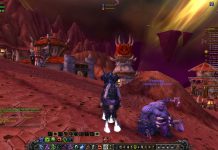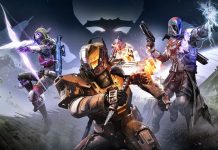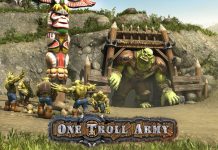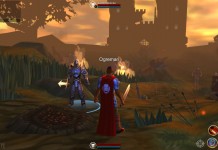We’re in the middle of 2012, the Year of Nostalgic Solo Games becoming MMOs—Torchlight II arrives on the scene right after Diablo III, which did exactly the same thing. In fact, Torchlight is another Diablo-clone that follows many of the same game elements that made the latter famous and the former an interesting knock-off title. It’s not exactly a straight MMO, but it’s contains a peer-to-peer multiplayer element that permits people to create and join games on the fly.
T2 is the sequel to Runic Game’s ARPG game Torchlight, which was more-or-less the spiritual sequel to Fate, developed by WildStudios and published by WildTangent. It contains all the same RPG elements, fishing, and the ability to transform a pet into a monster via feeding it fish. This is possibly because Travis Baldree is the designer of both games and you can feel his influence all over it.
As a result, T2 contains all the effects expected of a game with an ancestry like Fate and Torchlight. It has a distinct fantasy-esque game with a lot of steampunk elements. It’s a buy-to-play game with a box price tag of $19.99 and available from Valve’s Steam and from Perfect World Entertainment.
Graphics and Sound: It’s all it should be expected to be and a great deal of fun
Two elements strike out immediately from a game like Torchlight II: a fantasy-steampunk aesthetic and a cartoony atmosphere.
In the isometric view there’s zooming in and out, but no pan; fortunately, the environments are built so that there’s no need to pan. The game is extremely colorful and full of action. In fact, much of the game is seen through watching monsters charge and horror rain down upon them—until they explode in bloody chunks, splattering across the battlefield.
As a result, it’s a shiny adventure through a vivid land of beautiful textures. Almost that sort of adage, travel the world, meet new and exotic people, and get to kill them.
In fact, the game can get very busy during battles to the extent that it’s hard to follow who’s dying and where to go to stay away from the incoming firepower. Then again, it’s also possible to learn to recognize enemy spells by their effects and some of the stronger (and thus more dangerous) spells happen to telegraph themselves.
For people who played the original Fate and Torchlight series it will be a breath of fresh air. Although it doesn’t look quite like Torchlight, it maintains many of the same atmospheric aesthetics. It’s a bit simpler in its design and also a little bit more complex at the same time. The graphics are built around bringing the nature of the environment to the player and letting them explore (all the while mangling through mobs of enemies while prowling the countryside.)
The sound is also fairly distinct. The pets all make different noises as well as enemies in the field. In fact, it’s sometimes possible to anticipate a group of enemies before encountering them by listening to the ambient sounds—given that every class has a capability that literally obliterates goon enemies in one hit, often their sounds are more than enough to open up and kill them before the come on screen.
Each of the magical effects also have SFX sounds that fit their aspects. Electricity zaps, poison sizzles, fire fooms and crackles; and there’s a lot of reasons to enjoy the sounds of battle. Especially because the Ember Mage has an ability (under electricity, but it’s more like chaos) that randomly inflicts elemental damage…which means that it’s a lot like fighting a Jack-in-the-Box.
Gameplay: Isometric beauty in a shiny box where bloody explosions and elemental effects abound
As a Diablo-clone, Torchlight II effects a nostalgically familiar UI and an isometric RPG setting with gauntlets of monsters, click-to-move, and a vast number of skills to draw upon.
There are currently four character classes and they are not gender-locked: Engineer, an almost-tank who specializes in AoE attacks and team-support via robots; Outlander, a ranged fighter who dual weilds pistols, carries a long rifle, or a shotgonne; Ember Mage, a massive-damage-dealer who uses elemental effects, and can dual wield wands; and the Berserker, a heavy-melee fighter who specializes in claw weapons, hitting very hard, and moving very fast.
In fact, everyone in Torchlight II moves extremely fast. The maps are fairly broad and the mapping function in the UI is extremely functional—compared to Path of Exile’s map function it’s excellent. Monsters spawn all around the map, often in groups, and heroes tend to make mincemeat out of them every time they encounter them. Engagements often end in meaty explosions of gibs and sometimes splashes of elemental horror (ice, fire, electricity, and poison.)
Each of the different classes have skill trees that allow them to specialize into different roles for the group. The Engineer can specialize as a team support member with robots, increases to overall elemental effects, or into aegis with heavier armor, PBAoE, and the ability to draw fire from every direction. The Ember Mage can choose from different elemental effects massive-destruction on the fire side with explosions, seeking flames, billowing and conflagrations; with ice it’s all about weakening the enemy, freezing them in place, or turning them into frozen statues to shatter on impact; and finally there’s electricity that stuns, leaps from opponent to opponent, or delivers massive single (or multiple) target damage with tremendous arcs.
There’s also no-small number of pets available from a hawk, a Pomeranian, a wolf, even a weird sort of lizard, and even a ferret wearing goggles. When I played, I went with the ferret and named it after a friend of mine, Spyral, who owned a ferret named Schizo. Pets in Torchlight 2 are very important for much of the gameplay and provide much-needed support for players as well as extra inventory space.
When groups of enemies die, they explode in loot piñatas—leaving behind vast gold, and items, and much of the game is spent picking it up. Unlike Diablo or Path of Exile everything takes up exactly one inventory slot—although inventory runs out really fast. However, like all of the Fate and Torchlight series, the pet also has an inventory and can be sent back to town (a trip with a base of 2 minutes) to sell everything. It can even be given a shopping list of consumables to bring back.
The pet-inventory is one of the hallmarks of the Torchlight series.
Also important is the ability to dredge up fish from fishing holes that can be fed to the pet to transform it into terrific monsters. This can give a massive edge in a close fight, such as boss-fights, because each monster-transform has a special ability, added resistances, and sometimes increased damage. In fact, one of the most amusing transformation happens to be a pocketfish that turns it into a mimic—one of the most terrifying monsters from any RPG that looks like a treasure chest, but instead of being full of gold and items, it’s full of teeth.
Buy-to-play: Yes, but it’s a cheap $19.99 whoever you purchase it from and there’s no subscription fee
Torchlight II is the culmination of a solo-play game with a multiplayer addition. It’s not a traditional MMO in that it doesn’t give players a persistent world; but instead allows people to join together and play cooperatively in the same game. This is very similar to what games like Diablo III does…but there’s several fundamental differences.
The first is that the peer-to-peer element may mean that Runic Games will not need to support servers for the game. As a result, this game doesn’t operate under the same premise as most free-to-play games that need to support their player base. Using the multiplayer feature, I cannot tell if there is a server that allows players to find other games (but it seems to be the case.)
As a result, there doesn’t seem to be a cash shop or even subscription for players. After the box-fee of $19.99 to buy the game, it’s totally free from then on.
Conclusion: For $19.99 this is a fairly good game to play along with friends not to meet them
Even for someone who isn’t nostalgic about Fate or Torchlight this is an excellent example of an isometric RPG with a lot of reasons to play the game. At its core, T2 is a single player game with the ability to bring friends along—the peer-to-peer multiplayer means that you can reach out to friends to play alongside them. It’s just not like a standard MMO with a persistent world and ways to just run across other players.
If it’s really using a peer-to-peer structure to host and provide games, however, it might also be a new creature in the free-to-play market.
Graphically, gameplay, and narrative T2 is a beautiful game with a lot of love and care provided into it. It’s a loot-collecting, equipment upgrading, RPG-style with many reasons to run around, beat things down, open up chests, and send your pet scrambling back to town every 10 minutes overloaded with the bounty of the land.
Crushing enemies with friends is a pastime made popular in the gaming community by Diablo and Torchlight 2 is a reasonable addition to that tradition. In fact, the fish-transforming pets with their own inventory and the ability to send them back to town. As similar as it is to the now-staid isometric RPG, these things make it stand out.





















great review, cute little game but I doubt I would spend any money on it…
I am regular reader, how are you everybody? This post posted at this web page is actually
good.
Very cool Action role-playing game(ARPG) video game it seems good,it reminds me on Diablo but Diablo is much better .Gameplay is solid and graphic is solid too,I suggest this game everybody
Interesting role playing game,graphic solid too,i recommend it